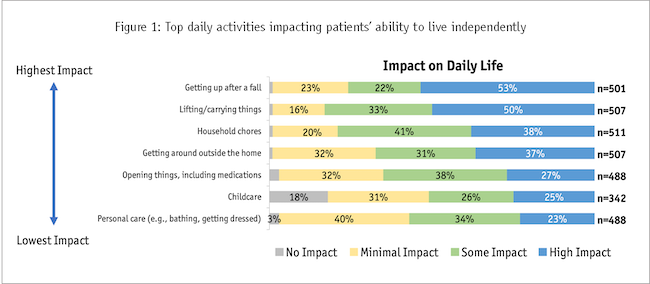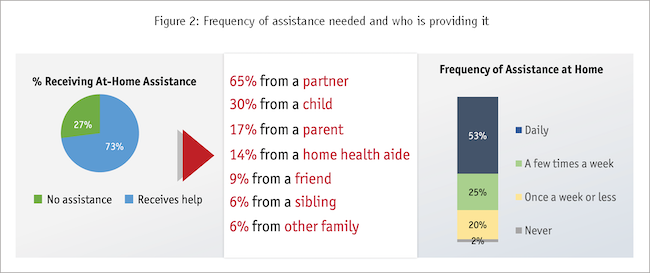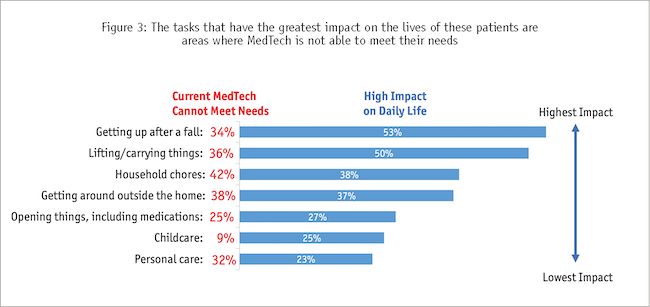Beyond functionality
Editor's note: Tom Donnelly is MedTech director at the Research Partnership. Mike Sabia is SEO director at InformYourCommunity. Kristy Beede is MedTech director at the Research Partnership.
We all want to be autonomous but a medical condition, an incident or aging may cause us to have difficulties with mobility and/or dexterity. These challenges often limit our independence, which can lead to a reliance on others to help with daily activities of living. However, the use of medical devices and technology (MedTech) can help overcome some of these challenges. Examples include simple devices such as a cane, walker, wheelchair or a grabber tool as well as high-tech solutions like an exoskeleton. In this article, we will describe the types of help these patients need, what devices and technology are currently used and explore unmet needs for companies to address. In addition to the findings of functional needs, our research uncovered insights on mental health needs.
Background
The inspiration for this research came from tangential findings from a packaging needs in-home ethnography study for Friedrich’s ataxia (FA) patients. In that research, respondents showed resilience, tenacity and positivity. They described how devices and technology increased their independence. One FA patient described how she renovated a ranch-style house to be a handicap-accessible smart home. This included easier access to the microwave and appliances, with countertops built such that her wheelchair could roll up under them. In addition, the lights, heat and locks were accessible via an app. These insights led to new research to explore in more depth what is currently being used, why some solutions were not being used and what their unmet needs are.
Method
The research evolved over several phases. The original study was conducted with 67 patients with Friedrich’s ataxia and presented at the 2022 Intellus Worldwide Institute.1 Next, the Clear Health Communications Taskforce at Intellus partnered with a marketing research class at Seton Hall University to extend the research in the spring semester of 2023. Seton Hall has a Market Research Center2 and offers both undergraduate and graduate marketing research classes. As part of those classes, students run a project that includes qualitative and quantitative research. They are always looking for clients that need help and these projects are a great way to get some research done while also giving back to the community by helping train the next generation of market researchers. While the research conducted with the students added new questions to explore, the sample size was small, so a new quantitative study was conducted.
The results discussed here are based on a 20-minute online survey with 637 patients with mobility and/or dexterity challenges through Rare Patient Voice including those with arthritis (203), rheumatoid arthritis (160), myasthenia gravis (124), multiple sclerosis (70), spine/brain injury (62), spinal muscular atrophy (24), fibromyalgia (24), amyotrophic lateral sclerosis (21), spina bifida (21), mitochondrial disease (15), Ehlers-Danlos syndrome (15), cerebral palsy (9) and Parkinson’s disease (6). (Note: some patients had more than one condition.) A handful of follow-up telephone interviews were conducted to gather additional details.
Challenges with daily activities
Respondents report a profound impact on their ability to independently complete activities that most take for granted. Some of these challenges are gross-motor movements, whereas others are fine-motor movement issues. Those that have the most impact on daily living are: getting up after a fall, lifting/carrying, household chores, getting around outside, opening things, child care and personal care (Figure 1).

Patients with these challenges in daily activities rely on others to help them in these areas (Figure 2). About three-quarters of respondents receive assistance in their home, with most of those (81%) having help from someone living with them. About two-thirds get help from a partner and almost a third get help from a child. Others get help from a parent (17%), a home health aide (14%), a friend (9%), a sibling (6%) or from other family members (6%). Just over half of respondents require assistance daily and a quarter a few times a week.

MedTech used and unmet needs
In addition to getting help from others, respondents use different types of technology and devices to address their struggles. Patients in our sample report the use of digital assistants (e.g., Alexa, Siri, etc.) for common tasks such as playing music, dictating, making calls, reminders and shopping. In addition, respondents report using digital assistants in ways that increase autonomy, including turning lights on and off, adjusting the thermostat and locking/unlocking doors. Devices commonly used include wheelchairs, grab bars, ramps, roll-in showers and accessible vans. Without these devices and technology, these patients would require more assistance, feel less independent, be unable to access certain things and take longer to accomplish tasks.
There are unmet needs in helping these patients with the tasks that have the most impact on their daily life (Figure 3). More than half of these patients say that getting up after a fall has a high impact on their life and a third of them say there is no current MedTech solution. While there are lifts, both manual and electric, that are used to help move a patient from a bed into a chair, they are operated by another person. Could similar MedTech be developed that can be used by the patient alone? Similarly, lifting/carrying is a challenge for half of these patients and about a third are unaware of a solution. There are unmet needs for helping with other difficulties in daily activities, including household chores, getting around outside and help with personal care. The ability to live alone comes down to navigating these challenges. As mentioned, most respondents rely on others to assist them, either family, friends or health aides. This is an area where MedTech companies could help.

There are many devices and technologies available that patients could use but are not currently taking advantage of, such as robot vacuums, adjustable beds and smart watches. The top reasons for not using tools like these are: patients are unaware of the solution; it is too costly; it is not worth the effort; or it is too complicated to adopt. Thus, in addition to creating MedTech solutions to address the top challenges, companies need to consider the reasons for patients not adopting currently available tools.
Mental health aspects
The use of devices and technologies evokes mainly positive emotional reactions, with some frustrations. Most of these patients find their use elicits positive emotions, such as feeling: more independent/self-sufficient; less burdensome to others; an increased sense of self-efficacy; more confident; and increased motivation/better morale.
One respondent mentioned that his use of a grabbing tool makes him feel accomplished: “I don’t feel like I’m at such a disadvantage. Even though I’m using a tool to get it done, I’m still getting it done.”
Use of these technologies can also occasionally cause negative emotions, such as: frustration in making it work; anxiety that it won’t help; feeling different from other people/drawing unwanted attention; and reminding them of their reliance on others.
The same respondent who was empowered by the grabbing tool mentioned that he felt “ashamed being 33 years old and walking around with a walker” when he looks fine. “That is a barrier you have to overcome. I’ve been doing this for a while and still haven’t.” While there are drawbacks to the use of tools, most of these patients seem willing to push past them to increase their independence.
While the functional help that devices and technology can provide these patients has been the main focus, patients’ mental health should also be considered. Most (88%) respondents indicated that their disability has an impact on their mental health. In fact, about half (51%) said the impact on their mental health was as severe or more severe than the physical limitations on their quality of life. For example, one respondent said, “The mental challenges are more difficult because I can’t see them coming, [whereas] the physical challenges, I’ve learned to adapt to overcome, and I can see those coming.” In fact, 85% of these patients said that the mental health impact alone has stopped them from performing necessary activities such as adhering to treatment, going to doctor appointments and grocery shopping.
Want to live independently
Patients with mobility and dexterity issues find everyday tasks challenging, which leads to lifestyle adaptations and mental health challenges. These patients want to live independently with little reliance on others and MedTech can help. The main aversion to pursuing new devices/technology is lack of awareness, costs and the effort required to adopt them. Patients have a general lack of knowledge of potential tools that can increase their autonomy. While most respondents say they are satisfied with their current devices, this study identified several unmet needs, including getting up after a fall, lifting/carrying, completing household chores, getting around outside, opening things, assistance with childcare and help with personal care. The mental health issues related to mobility and dexterity issues are common, serious and under-acknowledged.
The health care community should consider the perspectives of these patients by immersing in their world through patient journey and in-home ethnography research – which is what inspired this research. While there are solutions that will apply across most of the patients with mobility and dexterity challenges, there are distinct needs for specific conditions, as well as considerations for each specific patient. Many conditions are progressive (e.g., Parkinson’s), some are chronic and relatively stable (e.g., spinal cord injury) and others are acute and tend to improve over time (e.g., hip fracture).
This research also showed that, in addition to providing solutions to their functional challenges, MedTech designers and manufacturers should consider patients’ needs more holistically, beyond what a product does, and look for ways to also support patients’ mental health.
References
1 Tom Donnelly, Jason Mandelbaum, Sam Swanson, Kyle Bryant and Andrew Watson (September 15, 2022). “Home health technology for patients with mobility and dexterity issues.” Intellus Worldwide Institute. New Brunswick, N.J.
